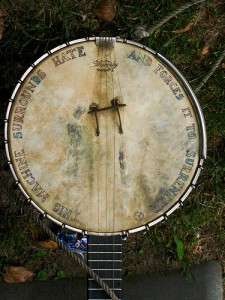You’ve probably heard a lot of Pete Seeger songs in the last couple of days. And no wonder: When Seeger died on Monday, he left behind a very long lifetime’s worth of beautiful, cheeky, unforgettable songs. But what he left me — and the millions of other kids who grew up along the Hudson River during his tenure there — is not a song but a story. And the story is as good a cure for cynicism as any I know.
It goes like this.
When Pete and his wife Toshi bought land in Beacon, New York, in the 1940s, moving upstate to Beacon was not a hip thing to do. The Hudson’s riverfront towns had busted decades earlier, and they were tough little places — still are, in many respects. Many obituaries have mentioned that at the time the Seegers arrived, the Hudson River was dirty. Well, it was filthy. Almost anyone could dump almost anything into the river, no permit required: sewage, garbage, industrial waste in all its awful variety. Bacteria consumed so much oxygen that fish sometimes suffocated in the water. Near Tarrytown, about 25 miles north of Manhattan, the color of the river changed to match the color of the paint applied to cars at the local General Motors plant. You didn’t fish in the Hudson if you valued your health, and you didn’t swim in it if you valued your life.
So Pete ordered up a big wooden boat. Which, at first, made sense to just about nobody. But Pete thought that a graceful, old-fashioned boat — a replica of the sloops that sailed the river in the 18th and 19th centuries — would draw people to their forgotten riverfronts, and that from the riverfronts they could imagine a different future for the Hudson.
The 106-foot-long Hudson River Sloop Clearwater sailed from a Maine shipyard in the spring of 1969, traveling south to New York City and then north to its home on the Hudson — into waters whose bacterial concentrations were 170 times safe levels.
The tall-masted sloop was hard to ignore, and so were Pete and his banjo. People did come to the broken-down riverfronts, and they did start to make noise, and the attention Pete and his allies drew to the deplorable state of the Hudson eventually contributed to the passage of the federal Clean Water Act in 1972. (While Congress debated the law, Pete pressed his case by sailing the Clearwater sloop to D.C. and holding an impromptu concert in the halls of Congress — which may or may not have helped.) The Clean Water Act regulated discharge and funded sewage treatment, and bit by bit the Hudson got cleaner. Levels of bacteria and pollutants declined. Fish returned, and slowly got healthier.
 The sloop kept sailing, and Pete kept playing, and when I was a kid in the Hudson Valley, in the 1970s and 80s, it was almost impossible to avoid the Clearwater sloop and its creator. Pete didn’t cloister himself like most celebrities, but played in classrooms and at festivals and everywhere in between. No matter their class or race or the politics of their parents, most Hudson Valley kids of my generation heard Pete’s banjo at some point, and most of them got to walk around on the deck of the Clearwater sloop: the boat sailed regularly up and down the river, most memorably in October, when it was piled with pumpkins to sell at the waterfronts. And every time we kids heard the music or saw the boat, we also heard the story.
The sloop kept sailing, and Pete kept playing, and when I was a kid in the Hudson Valley, in the 1970s and 80s, it was almost impossible to avoid the Clearwater sloop and its creator. Pete didn’t cloister himself like most celebrities, but played in classrooms and at festivals and everywhere in between. No matter their class or race or the politics of their parents, most Hudson Valley kids of my generation heard Pete’s banjo at some point, and most of them got to walk around on the deck of the Clearwater sloop: the boat sailed regularly up and down the river, most memorably in October, when it was piled with pumpkins to sell at the waterfronts. And every time we kids heard the music or saw the boat, we also heard the story.
The river was dirty, and now it’s cleaner. What’s wrong is being righted. What’s impossible is possible.
In the late 1980s, when I was a coxswain on my high school’s crew team, the river was clean enough to swim in after practice. The Poughkeepsie waterfront, close to where I grew up, was neither crowded nor lovely, but it was no longer a place to avoid.
Even so, Pete kept pushing. In the 1990s and 2000s, when his voice cracked and weakened, he surrounded himself with singing schoolkids and kept playing. He fought for for the cleanup of PCBs and other legacy pollutants in the Hudson. When he died, at 94, he was championing an initiative to build river pools on the Beacon waterfront reminiscent of the wooden swimming platforms that floated off Manhattan in the 1900s. “I usually tell people it’s halfway clean,” he said of the Hudson in 2004.
What’s impossible is possible. And the work is never done.
Photo of the Clearwater sloop on the Hudson courtesy of Flickr user Sea of Legs. Creative Commons.
Closeup of Pete Seeger’s banjo courtesy of Flickr user Paul VanDerWerf. Creative Commons.
Title from Seeger’s song “My Dirty Stream.” Worth a listen if you haven’t heard it.

This is the most beautiful tribute to Pete that I’ve read. Thank You!
Having grown up on the Hudson River myself during the 80’s and 90’s you perfectly described the impact that Pete and the Clearwater had on my childhood, and continues to have (much better than I could). Thank you.
Having lived in New York City and the Hudson Valley for over 30 years (1964-1998), I can attest to the absolute filth in the Hudson River.
We first saw the Clearwater when it was under construction at the South Street Seaport in Manhattan. We became members as soon as we could afford it. But, much as I had loved Pete since the late 50’s and much as we believed in his ideals for the river, we never really believed that the Hudson would ever be clean an decent in our lifetimes. But, by the mid 80’s fishermen from Columbia and Green counties were allowed to sell fish for the first time in decades. Shad roe, a delicacy of the 19th century was now available and safe to eat. His energy, joy and charisma accomplished more than we could have ever hoped.
Pete Seeger was one of the most inspirational people in my life and many of my generation. I don’t think we’ll ever see his like again. A true magician.
Thank you Michelle for a very touching tribute to Pete Seeger. I remember many a summer evening sailing on the Clearwater. Pete did so much to clean up the river.
We weren’t from the Hudson River Valley, but I have vivid childhood memories of chasing the Clearwater and just missing her for an entire weekend. Pete’s music and legacy rang out in singalongs across many a waterway. Sail on.
Like others I enjoyed the Seeger piece, but in my case
it reminded me of the effort to clean up the Willamette
River as it flowed through my hometown of Portland, Oregon.
To day there are dragon boat races on the river, but as a kid I
recall it, too, was awash with industrial waste. Once again
an example of how folks today take for granted what it took
for some really dedicated people to accomplish a cleanup
Thank you, Michelle, for this rich, touching tribute to Pete! Clearwater also impacted my life: http://www.hothousemagazine.org/pete-seeger-my-onetime-boss-dies/. And I love these words you wrote: “The river was dirty, and now it’s cleaner. What’s wrong is being righted. What’s impossible is possible.” Indeed.